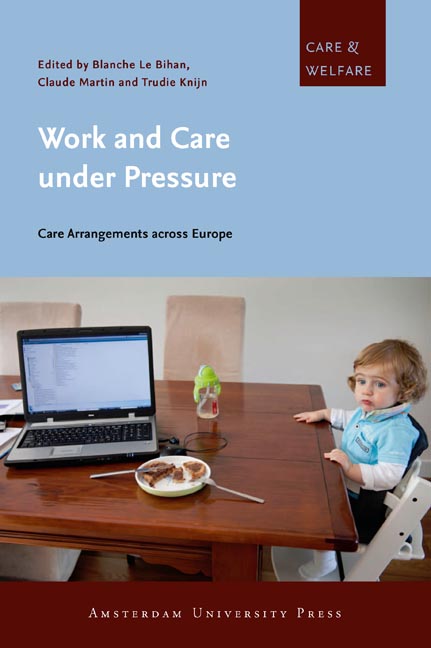Book contents
- Frontmatter
- Contents
- 1 Introduction: Workers under pressure and Social care Arrangements: A Research Framework
- 2 Work-family Balance in the Netherlands: Work and Care Culture Mediating Between Institutions and Practices
- 3 Negotiating Gender Equality, Atypical Work Hours and Caring Responsibilities: The case of Sweden
- 4 Caregiving and Paid work in Germany: The Impact of Social Inequality
- 5 Working Caregivers ‘Living Under Pressure’ in France
- 6 Negotiating Work and care in a Changing Welfare Regime: The case of Portugal
- 7 Blurring Boundaries and Clashing Loyalties: Working and caring in Italy
- 8 The changing mix of care in six European Countries
- About the Contributors
- Care & Welfare
1 - Introduction: Workers under pressure and Social care Arrangements: A Research Framework
Published online by Cambridge University Press: 06 January 2021
- Frontmatter
- Contents
- 1 Introduction: Workers under pressure and Social care Arrangements: A Research Framework
- 2 Work-family Balance in the Netherlands: Work and Care Culture Mediating Between Institutions and Practices
- 3 Negotiating Gender Equality, Atypical Work Hours and Caring Responsibilities: The case of Sweden
- 4 Caregiving and Paid work in Germany: The Impact of Social Inequality
- 5 Working Caregivers ‘Living Under Pressure’ in France
- 6 Negotiating Work and care in a Changing Welfare Regime: The case of Portugal
- 7 Blurring Boundaries and Clashing Loyalties: Working and caring in Italy
- 8 The changing mix of care in six European Countries
- About the Contributors
- Care & Welfare
Summary
Reconciling work and family life – or reaching a work-family balance, as it has been called recently in the literature (Guest 2002; Frone 2003; Abigail & Milner 2003; Hantrais & Ackers 2005; Van der Lippe, Jager & Kops 2006; Van der Lippe & Peters 2007; Lewis 2009a; Hobson 2011) – is at the core of Europe's social policy agenda as well as that of many of its member states. It has also been the subject of (comparative) academic research ever since the 1970s. For much of the last four decennia, the focus of social policies (and of many academic studies) has been on the way in which gender inequality – expressed in women's family care responsibilities – has restricted the full participation of women in the labour market, their career perspectives, their (economic) autonomy and independence, their social participation and their self-development.
Recently, a turning point has been reached in that the lens is now also being directed at the effects of employment on gender-equal family life. This approach can be ascribed to three parallel developments. First, in many countries, the majority of women (with or without dependent family members) are in paid employment, although not always and everywhere in full-time jobs (OECD Employment Outlook 2012). Second, the post-industrial labour market – with its irregular working times, precarious and flexible jobs, and increasing productivity – is influencing family life in an unforeseen way (Guest 2002; Drobnic & Guillén 2011). Third, evaluations of the diversification of care arrangements (via the state, the market, taxation systems, etc.) make it clear that the family will remain the last resort when it comes to care work (Leira & Saraceno 2002; Gerhard, Knijn & Weckwert 2005; Da Roit 2010). The perspective that until recently had been dominant – that public care should fully substitute for mainly women's family care – has been recognised as unrealistic and even undesirable. Although men's contribution to family care work has been increasing, it still lags far behind women's share in family care work. Therefore the focus has shifted to the dual aims of protecting some time for caring for family members and of reaching a genderequal sharing of work and care (Knijn & Kremer 1997; Lewis 2009a).
- Type
- Chapter
- Information
- Work and Care under PressureCare Arrangements across Europe, pp. 7 - 32Publisher: Amsterdam University PressPrint publication year: 2013



